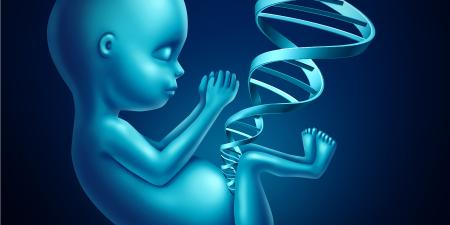Family formation through assisted reproductive technologies (ART) accounts for 3 of every 100 children born in the United States today [1-3]. The demographic of ART-conceived children far exceeds the number of parent-child relationships formed through neonatal adoption, offering opportunities for parenthood that would have been elusive a generation ago. While the majority of ART usage involves couples undergoing in vitro fertilization using their own gametes—known as first-party assisted reproduction—a growing percentage of ART use involves third-party collaborators who assist in an individual’s or couple’s reproductive plan. These third party collaborators participate as sperm donors, egg donors, and gestational carriers; they are typically unrelated to the intended parent or parents and receive compensation for providing gametes or gestational services to the sponsoring prospective parent(s). The vast majority of third-party assisted reproduction scenarios proceed without complication or incident, but occasional mishaps do occur and are worthy of analysis [4].
In contrast to natural reproduction which enjoys the privacy and security of a closed two-party relationship, assisted conception is vulnerable to misconduct by the necessary presence of third parties in the reproductive equation. Ideally, all potential conduct attendant to a collaborative reproduction arrangement should be addressed by a written preconception agreement in which all parties participate voluntarily, transparently, and in good faith. In the event such an agreement is absent, deficient, or breached, intended parents, donors, surrogates, and physicians are best served by understanding their duties and the possible conflicts generated by each scenario. In a clinical practice that combines profound intimacy with arm’s-length negotiated transactions, incidents of malfeasance can cause devastating emotional, psychological, physical, and financial harms. I explore these potential harms through three paradigmatic cases—the deceitful donor, the disobedient surrogate, and the divorcing intended parents.
Donor Misconduct: Adventures in Truth Telling
Gamete donors typically undergo extensive screening to determine their genetic, physical, psychological, and behavioral suitability to contribute eggs or sperm for another’s reproductive plan. Nevertheless, donors can be less than forthcoming about at least two key aspects of their profile—their intentions to claim parental rights over any resulting children and their health histories. Active misrepresentation or passive omission of these essential facts may be revealed to a physician in the course of donation. In egg donation, particularly, an infertility specialist may treat both the intended mother and her chosen donor and become aware of misrepresentation. What course of conduct is open to a doctor who learns of donor deceit?
As to the problem of undisclosed parental aspirations, intended parents who solicit gamete donors commonly presume the donors will neither retain nor assert any parental rights over a resulting child. American courts have processed more than a handful of cases in which donors initially declare a lack of intent to parent any resulting child, but harbor or later develop a desire to do so. Sperm and egg donors who were acquaintances of an intended mother at the time of donation have been awarded parental rights after stepping into a parenting role once the child is born [5-8]. What is the physician’s role if a gamete donor discloses an intent to parent a resulting child after representations to the contrary?
Dilemmas in ART often pit two longstanding professional duties against each other—the duty to obtain informed consent and the duty to maintain patient confidentiality [9, 10]. Obtaining informed consent from a patient requires disclosure of any information that would be material to that person’s decision to undergo or refuse treatment. Exceptions are limited to situations involving the patient’s impaired decision-making capacity and do not apply in the case of donor misrepresentation [11]. Standing alone, the duty to obtain informed consent demands disclosure of a donor’s “true intent” because such information is clearly material to a patient’s decision to proceed with or continue the existing ART arrangement.
Knowing the limits and demands of disclosure is especially complicated when a physician treats both the donor and the intended mother, forming sacrosanct patient-physician relationships with both parties. A key feature of that relationship, the duty to maintain patient confidentiality, is essential to the patient’s feeling free and safe to discuss matters of the utmost intimacy. Unconsented disclosure to any third party, especially another patient with a vital stake in the disclosing patient’s care, must be carefully considered.
A first approach to managing the conflicting professional demands may be to consult preexisting written agreements between the parties for language about disclosure of material information. In some instances, parties waive their rights to physician confidentiality, enabling a treating or facilitating doctor to share important information with and about each signatory. Absent express waiver by the patient, disclosure may still be permissive. The duty to maintain patient confidentiality is not absolute. Disclosure of confidential patient information is permitted under certain circumstances, including an aim to avoid serious harm to a third party [10]. Assertion of parental rights by a gamete donor would, in all likelihood, inflict serious harm on the intended parents. Thus, unconsented disclosure can be justified. Ideally, the physician would convince the donor to discuss her thoughts and feelings about parenthood with the intended parents, but if she refuses the physician could proceed with the necessary disclosure.
These same conflicting duties of informed consent and confidentiality arise when a donor reveals previously undisclosed features of her health profile, such as a family history of heritable disease, untreated bouts of depression, prior substance abuse, or participation in a failed egg retrieval cycle. Some post-screening revelations may involve criteria that would have excluded the donor from eligibility under either federal or industry standards [12, 13]. Even if they are not grounds for excluding the donor, factors like those mentioned above would most likely have dissuaded the intended parent(s) from choosing the donor, and, thus, the information is highly material to the patient’s assisted conception treatment. Further, while misrepresentations about a donor’s parental aspirations are harmful to the intended parent(s), withholding or lying about health-related matters additionally threatens the well-being of a potential child.
A physician who becomes aware of previously undisclosed health-related information should discuss it with the donor. The donor may confirm the information and ask to withdraw from the arrangement. If the donor seeks to do so without alerting the intended parents to her nondisclosure, her request should be honored. The intended parent(s) can be informed that the prospective donor has been excluded from donating, but specific health-related findings need not be disclosed.
In other instances, a donor may wish to continue the treatment process, perhaps hopeful she remains a good candidate for donation. If the new information renders the donor ineligible under state, federal, or industry guidelines, she must be excluded from further participation. If she remains eligible for donation, with her express consent a physician can relay the newly discovered information to the intended parent(s) for their consideration. In all likelihood, discovery of new and potentially troublesome information at this late stage in the donation process will be difficult for all the parties involved. Physicians are encouraged to make themselves available for a candid and thorough group discussion.
Surrogate Parenting Arrangements Gone Awry
Surrogate parenting arrangements enable infertile women and same-sex male couples to become parents with the assistance of a gestational carrier who carries the child from implantation to delivery. In the main, these arrangements are memorialized in detailed agreements negotiated by the parties and their attorneys. In addition to provisions regarding compensation, surrogate parenting agreements contain language addressing the parties’ expected behavior during the course of the pregnancy [14]. What is the physician’s role in the face of a breach by the intended parents or the surrogate?
Professional societies strongly urge physicians to refrain from treating both the intended parents and the surrogate “because conflicts of interest may arise that would not allow the physician to serve all parties properly” [15]. Despite this recommendation, dual treatment may be preferred when an intended mother undergoes oocyte retrieval to contribute to the embryos transferred into the surrogate. A reproductive medicine specialist may continue to see both the intended parents and the surrogate until her pregnancy is well established. What if, during this period of overlapping patient-physician relationships, the doctor learns of behaviors that violate the surrogacy agreement? Imagine the intended parents confide their marital discord and impending divorce in the face of a specific contract term requiring delivery of the child to an intact married couple [16]? Or consider a surrogate who confesses noncompliance with an “organic foods only” provision or enjoyment of contractually prohibited coffee and alcohol on a regular basis.
As a foundational matter, physicians involved in third-party reproduction should familiarize themselves with the written agreements their patients have signed [15]. If a contract calls for the sponsoring couple to be married at the time of the child’s birth or for the surrogate to eat a certain diet (including avoiding named substances), a physician can assume these behaviors are material to the parties’ decision making. In many instances, the parties’ preferences regarding the scope of disclosure required and permitted in the arrangement, including disclosure by physicians and other health care professionals, are embedded in the surrogacy contract. A careful drafter will appreciate and memorialize the need for parties to a surrogacy agreement to waive confidentiality to any material information discovered in the course of treatment. Express waivers of confidentiality represent an exception to a physician’s duty to maintain patient confidentiality. Under these circumstances, a physician can consider a two-part approach: (1) encourage the patient to disclose the breach to the other party, and (2) failing self-disclosure, the physician can discuss the breach with the affected party as material to their ongoing informed consent.
If the parties have not expressly waived confidentiality, practitioners must weigh the benefits and burdens of nonconsensual disclosure. Assisted reproduction scenarios are further complicated by the potential interests of offspring who may exist in vitro or in utero. Respect for patient autonomy includes the duty to provide information material to a patient’s decision making. Since breach of an agreement could provoke recision of the contract, the potential balance of harms seems to weigh in favor of disclosure.
Conclusion
Assisting infertile patients become parents can be a richly rewarding area of practice, though its challenges often extend beyond the bedside. Physicians can best navigate any clinical and ethical challenges by familiarizing themselves with the terms of any written agreements, encouraging full self-disclosure by the parties, and respecting patient autonomy by adhering to the principles of informed consent.
References
-
Centers for Disease Control and Prevention Assisted reproductive technology: 2010 national summary report. http://www.cdc.gov/art/ART2010/PDFs/ART_2010_National_Summary_Report.pdf. Accessed November 20, 2013. This reports the birth of 61,564 IVF-conceived infants in 2010.
-
Institute for Science, Law & Technology Working Group (ISLAT). Art into science: regulation of fertility techniques. Science. 1998;281(5377):651-652. This reports 60,000 births of children conceived through artificial insemination by donor (AID) annually.
-
Centers for Disease Control and Prevention. Births: final data for 2010. Natl Vital Stat Rep. Aug. 28, 2012; 61(1):1. http://www.cdc.gov/nchs/data/nvsr/nvsr61/nvsr61_01.pdf. Accessed November 19, 2013. This reports 3,999,386 live births in the US in 2010. Thus, children conceived through ART (combined IVF and AID) in the US in 2010 comprised 3 percent of all live births.
-
Hansen M. As surrogacy becomes more popular, legal problems proliferate. ABA J. 2011;97:52-57. http://www.abajournal.com/magazine/article/as_surrogacy_becomes_more_popular_legal_problems_proliferate/. Accessed November 20, 2013.
-
Thomas S. v Robin Y., 209 AD 2d 298, 618 NYS2d 356 (1995).
-
Jhordan C. v Mary K., 179 Cal App 3d 386, 224 Cal Rptr 530 (1986).
-
K.M. v E.G., 37 Cal 4th 130, 117 P3d 673, 33 Cal Rptr 3d 61 (2005).
-
T.M.H. v D.M.T., 79 So 3d 787 (FL 2011).
-
American Medical Association. Opinion 8.08 Informed consent. Code of Medical Ethics. Chicago, IL: American Medical Association; 2006. http://www.ama-assn.org/ama/pub/physician-resources/medical-ethics/code-medical-ethics/opinion808.page. Accessed November 20, 2013.
-
American Medical Association. Opinion 5.05 Confidentiality. Code of Medical Ethics. Chicago, IL: American Medical Association; 2006. http://www.ama-assn.org/ama/pub/physician-resources/medical-ethics/code-medical-ethics/opinion505.page. Accessed November 20, 2013.
-
American Medical Association. Opinion 8.082 Withholding information from patients. Code of Medical Ethics. Chicago, IL: American Medical Association; 2006. http://www.ama-assn.org/ama/pub/physician-resources/medical-ethics/code-medical-ethics/opinion8082.page. Accessed November 20, 2013.
-
US Food and Drug Administration Center for Biologics Evaluation and Research. Guidelines for industry: eligibility determination for donors of human cells, tissue and cellular and tissue-based products (HCT/Ps) [2007]. http://www.fda.gov/downloads/BiologicsBloodVaccines/GuidanceComplianceRegulatoryInformation/Guidances/Tissue/ucm091345.pdf. Accessed November 19, 2013.
-
Practice Committee of the American Society for Reproductive Medicine; Practice Committee of Society for Assisted Reproductive Technology. Recommendations for gamete and embryo donation: a committee opinion. Fertil Steril. 2013;99(1):47-62.
- Fruchtman C. Considerations in surrogacy contracts. Whittier L Rev. 1999;21(2):429-433.
-
American College of Obstetricians and Gynecologists Committee on Ethics. ACOG committee opinion no. 397: surrogate motherhood. http://www.acog.org/Resources_And_Publications/Committee_Opinions/Committee_on_Ethics/Surrogate_Motherhood. Accessed November 19, 2013.
-
In re Marriage of Moschetta, 25 Cal App 4th 1218 (1994).



